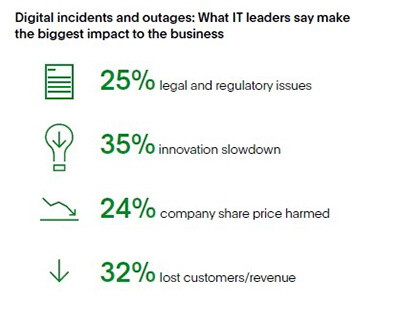
The Importance of a Well-Architected Network Part 1: Understanding the Devastating Impact of Outages
The network is the backbone of the enterprise. Your network is mission-critical, and the success of your company depends on it. Your business operations, communications, sales and customer service all rely on an available, high-performing and resilient network.
Today, your network is more than just on-site networking components – it includes connections between your globally distributed workforce, data centers and multi-cloud cloud architecture. When designing, upgrading or expanding this network, you must take steps to minimize the impacts of outages and performance degradation. You need a Well-Architected Network.
In this blog series, I will delve into the foundational pillars, the advantages and best practices of a Well-Architected Network. In this first blog, I start the discussion by presenting the challenge: the negative impact network outages can have on an organization.

IT Downtime: An Increasing Problem
Network-related issues are the largest single cause of IT service outages, according to the Annual Outage Analysis 2024 from Uptime Institute.1
Research in 2024 from analyst firm Enterprise Management Associates (EMA) found that 14% of respondents experience significant outages weekly, with 30% monthly, 30% quarterly and 10% yearly.2 New Relic's Observability Forecast 2023 uncovered even more concerning statistics, with 32% of survey respondents saying high business-impact outages happen once per week or more, while 13% still experience outages once a day or more.3 Although the percentages of these two reports differ, they still demonstrate how many organizations are hampered by IT service outages that severely impact the business on a regular basis.
New Relic also notes that high business-impact outages tend to take the longest to resolve, with 60% saying it takes more than 30 minutes, and 34% saying it takes more than an hour.3 Similarly, EMA found that 65% of respondents report resolution takes between 30 minutes and two hours.2 In businesses where minutes count, these outages can be devastating.
Even more concerning, the problem presented by outages is not going away. According to 2024 research from PagerDuty, more than half (59%) of IT leaders say customer-impacting incidents have increased, growing by an average of 43% in the last 12 months.4 LogicMonitor's 2023 report, The Race to IT Observability, confirms this statistic, with 51% of enterprise IT leaders experiencing an increase in IT downtime since March 2020.5

Source: PagerDuty
The Direct Cost of Outages
The most noticeable impact of an outage is the direct cost. A 2024 Splunk report, The Hidden Costs of Downtime, calculates average downtime for the top 2000 public companies to cost $200 million per company per year, representing 9% of profits.6
“Lost revenue is number one on the list of direct costs at $49M annually … Sixty-one percent of all respondents call it 'very' or 'prohibitively' damaging,” the Splunk report explains, adding that it takes 75 days for revenue to recover. The second largest cost is regulatory fines, averaging $22 million per year, and missed SLA penalties are third at $16 million.
According to New Relic, 61% say outages cost at least $100,000 per hour of downtime, while 32% say at least $500,000, and 21% say at least $1 million.3 EMA estimates an average downtime cost of $1.4 million per hour for companies over 10,000 employees.2
Looking at the annual cost of outages, New Relic calculates the median cost of high-business-impact outages as $7.75 million per year,3 while PagerDuty found that organizations saw an average of 25 major incidents in the last 12 months, adding up to just under $20 million per year, per organization.4
Although these numbers vary across the different reports, one point is made clear: the cost of an outage is substantial, highlighting the acute need for a Well-Architected Network that can withstand outages.
The Hidden Costs of Outages
In addition to the direct costs, outages also have a significant negative impact on less quantifiable – but just as critical – factors such as business operations, employee productivity, and customer satisfaction. The Splunk report confirms that the consequences of downtime go beyond immediate financial costs and take a lasting toll on a company’s shareholder value, brand reputation, innovation velocity and customer trust – pointing out that hidden costs are harder to measure but can be just as detrimental.6
“Downtime creates a tidal wave of side effects that reach every corner of an organization,” the Splunk report states. “From security, ITOps, and engineering teams stuck in the maze of root cause analysis to CMOs forced to pivot marketing and communications to crisis management — and even CFOs watching stock prices plunge in the blink of an eye.”
The following are some alarming risks posed by IT service outages:
Negative customer experience: According to Splunk, 41% of tech executives admit customers are often or always the first to detect downtime. In addition, 40% of CMOs add that downtime impacts customer lifetime value. Almost one third (29%) of respondents lost customers because of downtime, while another 44% say downtime damages their reputation.6
Reduced workforce productivity: During a network outage, employees cannot access communication and collaboration platforms, business tools, and other essential applications, bringing many tasks to a complete halt, and severely reducing team productivity across a variety of departments. The LogicMonitor report shows that 66% of respondents experienced lost productivity as a result of IT brownouts, while 61% experienced lost productivity as a result of IT outages.5
Innovation disruptions: Three quarters (74%) of technology executives surveyed by Splunk experienced delayed time-to-market, and 64% experienced stagnant developer productivity due to IT outages.6
“When downtime occurs, whole teams must shift from high-value work (like launching new digital products and experiences) to applying software patches and participating in postmortems … Productivity plummets, innovation velocity and time-to-market slows, hurting competitive position and likely costing upwards of tens of millions in aggregate,” the Splunk report warns.
Tarnished brand reputation and customer trust: PagerDuty research shows 90% of respondents revealing that outages or disruption have reduced customer trust in their organization,4 and LogicMonitor reports that 32% of enterprises have endured brand/reputation damage due to IT outages.5 The Splunk report adds that, after an outage, companies spend an average of $14 million to repair reputations.6
Diminished shareholder value: The ultimate negative for a public company is the loss of stock value, and PagerDuty says 24% of respondents reported outages negatively impacting share prices.4 Similarly, 28% of Splunk survey respondents say downtime diminishes shareholder value, and stock prices can drop by as much as 9% after a single downtime event – taking an average of 79 days to recover.6
Conclusion: A Matter of Survival
Even before you saw this blog, it probably seemed obvious that network outages wreak havoc on the business, but these eye-opening numbers put the challenge into stark perspective. Minimizing network outages is a matter of survival for any business in the digital age, and a Well-Architected Network is the solution to deliver availability, reliability and performance. Check back on CoreSite's Connect[ED] Blog for Part 2 of this blog series, outlining the key pillars of a Well-Architected Network.
Know More
Schedule a meeting with CoreSite today to find out how we can help you connect to colocated data centers and the cloud with a Well-Architected Network.
When you are ready, CoreSite will be ready to help plan and execute a strategy for interconnection that will drive the collaboration and digital transformation you seek.
References
- Annual Outage Analysis 2024, Uptime Institute, 2024 (source)
- IT outages: 2024 costs and containment, Enterprise Management Associates (EMA), April 25, 2024 (source)
- Observability Forecast 2023, New Relic, 2023 (source)
- Customer impacting incidents increased by 43% during the past year-each incident costs nearly $800,000, PagerDuty, 2024 (source)
- The Race to IT Observability, LogicMonitor, 2023 (source)
- The Hidden Costs of Downtime, Splunk, June 2024 (source)








